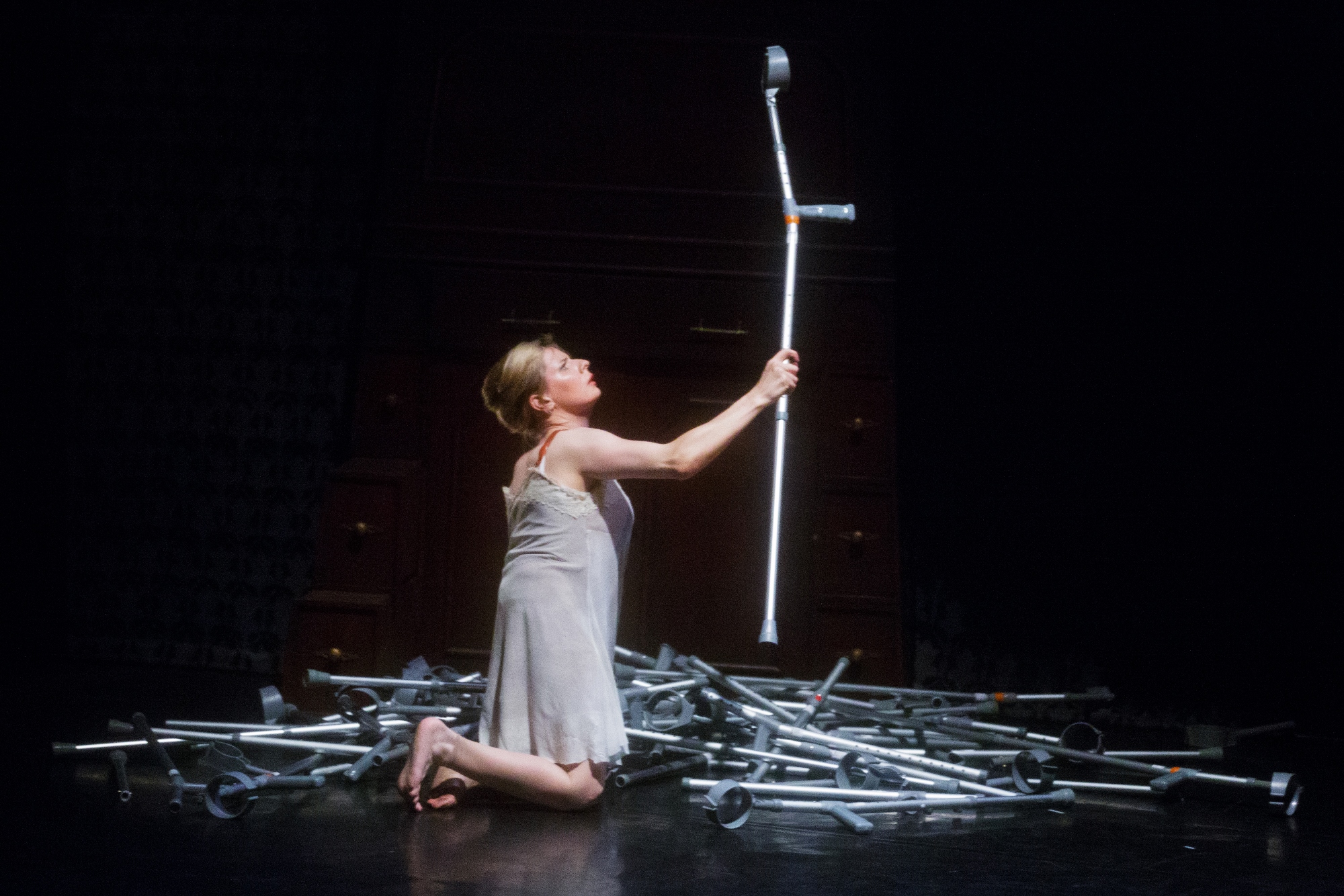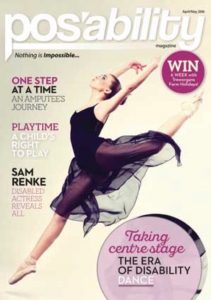
“Disabled arts has gone much further in dance than it has in any other art form,” insists Robert Softley Gale. “I think it’s because we can bring our own body to the party; it’s not about doing a classical text or any of that sort of thing, it’s about being real.”
 Robert is one of Scotland’s most prominent disabled artists, with a constantly full diary thanks to his work as a disability rights activist, actor and performer, writer, co-artistic director (of Glasgow-based Birds of Paradise Theatre Company) and supporter and advocate of equality of access to the arts through both his own company, flip, and as a board member keeping an eye on the work of the National Theatre of Scotland.
Robert is one of Scotland’s most prominent disabled artists, with a constantly full diary thanks to his work as a disability rights activist, actor and performer, writer, co-artistic director (of Glasgow-based Birds of Paradise Theatre Company) and supporter and advocate of equality of access to the arts through both his own company, flip, and as a board member keeping an eye on the work of the National Theatre of Scotland.
Robert’s most recent directorial project for Birds of Paradise was Purposeless Movements, performed at some of Scotland’s most prestigious venues – Tramway (the home of Scottish Ballet, in Glasgow), the Traverse Theatre (in Edinburgh), and Eden Court (in Inverness). The much-praised show combined speech, British Sign Language and captioning, music and choreography to make both serious and humorous points about the lives of the four actors who took part, each of whom has cerebral palsy (CP).
“A lot of my work is looking at how disabled people move and how we’re perceived by how we move,” Robert says. Certainly, that formed the basis of his acclaimed one-man show, If These Spasms Could Speak; Purposeless Movements, however, took things to the next level. It was a multi-person piece as much about gender as disability; plus, of course, it was an attempt to reclaim the medical diagnosis. “It’s a medical diagnosis that cerebral palsy gives you purposeless movements, but what does that mean? What movements have purpose, and which don’t? And how do you know which is which?”
To help develop Purposeless Movements, Robert brought on board the choreographer and performer Rachel Drazek, who had previously appeared in the 2015 Birds of Paradise production, Crazy Jane – where, again, movement and choreography were considered a vital tool in portraying and exploring characters on stage. “Robert was interested in continuing to work with me,” Rachel explains, “pushing further into what movement might mean in terms of identity and whether disability has a part in that or not.”
A significant aspect of Rachel’s work on Purposeless Movements was how she “found” the choreography within the performers, rather than simply imposing movements on them. It’s generally the way she works, although it’s not without risks. “On Day One, it was really scary, because nobody knew anything,” she says. “We just had loads of questions and no answers at all. Robert was like: ‘Ok, off you go, make a dance show’ – with four non-dancers, with varying degrees of CP and experience, all of them new to me in a working capacity.”
During the relatively short number of weeks to prepare the show, Rachel gave her cast – Colin Young, Jim Fish, Pete Edwards and comedian Laurence Clark – different physical and verbal tasks. “It was just to see who they were in the room, how their bodies moved, what they responded to, what was comfortable for them and what was not,” Rachel adds. “Robert and I were very interested in when it felt uncomfortable; was it the movement itself or because it’s a disabled people and movement?”
Although currently based in London, Rachel works all over the UK and particular loves returning north of the border. “I feel that there’s a real interest in bodies and movement in Scotland,” she says. “Because the scene here is a little bit smaller, it’s easier to keep track of what’s happening. Conversations develop a little more, whereas in London it’s hard to know who’s doing what. It’s just a little bit more concentrated in Scotland; the scene seems to be a little easier to follow, which is really exciting because it feels like you’re contributing to something. For me, it’s a real treat to be invited into that.”
Scotland’s dance scene may be smaller, but it involves not just many of the UK’s most innovative choreographers and performers, but also national arts funding body Creative Scotland, funds from the Scottish Government and national companies including Scottish Dance Theatre (based at Dundee Rep) and the National Theatre of Scotland.
Australian-born, Glasgow-based Caroline Bowditch’s first major dance piece as a choreographer was Leaving Limbo Landing, part of the Unlimited programme for disabled artists running during the London 2012 Cultural Olympiad. She insists that a significant factor in its development was her four years as Dance Agent for Change at Scottish Dance Theatre. Funded by The National Lottery through Creative Scotland, Caroline’s role in Dundee was to increase the number of disabled people involved in dance in Scotland, including those entering training or the dance profession. She interacted with more than 25,000 people through numerous workshops, talks and performances in Dundee, Scotland and the rest of the UK.
“It was a very comfortable role that I had with them,” she says. “It was challenging, but it was doing all the things that I wanted it to do. To have that commission coming out of a role like that, which had given me lots of profile, was hugely significant, because that was the first time that I’d made a piece just under my own name. I’d worked with other companies, but had never ever had a work branded as Caroline Bowditch. So that was pretty significant.”
She continues to tour her more recent work, Falling in love with Frida, most recently as part of the Mardi Gras in Sydney, Australia. “A point of the Unlimited commissions was that they were all about pushing disabled artists to places they’ve never gone before, and I think I absolutely took that at its word,” Caroline adds. “I have done exactly that. I feel I’m at a place where I can’t go back, I can only go forward. A lot of people have invested a lot of time and energy and money in me now, too much to not make the most of that development and to take my artistic career as far as I can.”
Investment of time – and money – is, of course, vital if any artist is to build up a body of work, as the choreographer and performer Claire Cunningham knows well. In March she completed a two-week, 12-performance run of her show Guide Gods at the Perth International Arts Festival, Australia’s longest-running cultural festival; the show was originally commissioned as part of the wider cultural celebrations held around the Glasgow 2014 Commonwealth Games.
Arguably Claire’s most famous work, the award-winning Ménage à Trois (which she’s likely to tour again next year) was commissioned as part of the London 2012 Cultural Olympiad and produced in partnership with the National Theatre of Scotland. Like deaf dancer Ramesh Meyyappan, Claire has also more recently received support and recognition from the both the British Council and the Scottish Government’s Edinburgh Festivals Expo Fund.
It’s good news that Scotland is now home to many internationally recognised disabled dance artists, but the question then follows: what happens next? It’s an issue that had concerned Robert Softley Gale for some time, but it was only towards the end of 2014 that he was able to do anything about it, when he and his business partner Mairi Taylor created flip artists.
“We got funding from the Esmée Fairbairn Foundation to run a year-long programme for nine disabled artists who were at the verge of becoming professional but were not quite there yet,” he explains. “Individual artists could develop their practice, and also their career and networking skills – all the other stuff that you have to do as an artist. The aim was to develop individual artists who can then make their own way.”
One of those nine artists is dancer Neil Joseph Price, who worked with Royal Conservatoire for Scotland lecturer Gary Gardiner to create his first self-choreographed piece, which is based on Neil’s relationship with Uist, where he grew up. Neil also received support as part of the Federation of Scottish Theatre’s mentoring programme, Step Up, while continuing a decade’s work with Glasgow-based inclusive dance company Indepen-dance. “My uncle is a choreographer and I wanted to try it for myself because I’ve not done anything like that before,” Neil explained as part of the flip artists project report.
So does the increased profile of disabled artists – and, in particular, disabled choreographer-performers like Caroline and Claire – bode well for the future? “I’m always a wee bit uncomfortable about the ‘role model’ thing, because I know me,” Robert says. “Also, can I inspire people who are very different from me? Having said that, there is a real value in seeing what other people can do: confidence is a massive thing for a lot of people – disabled or not. Yet we need to support disabled performers to be the best they can, and that won’t just happen by itself.”
First published by PosAbility, April/May 2016.